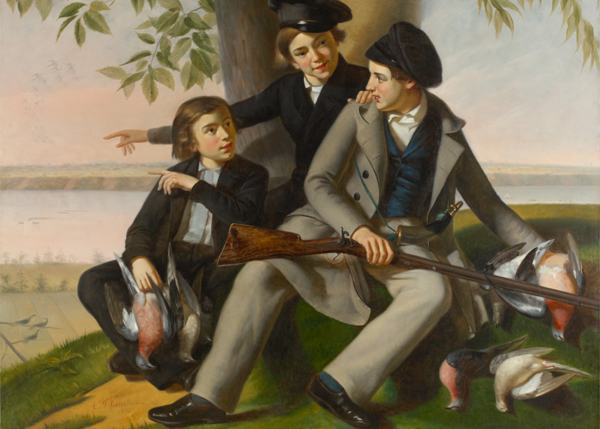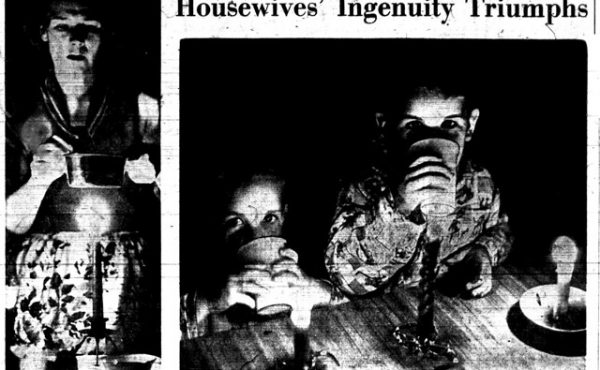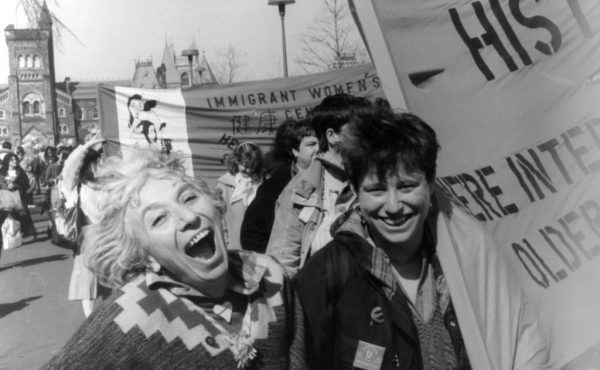Pigeons have been living with people for literally as long as anyone can remember. They were one of the first animals we ever domesticated — sometime back in the days of prehistory. Pigeons are already there in some of the oldest records we have: Egyptian hieroglypics, Mesopotamian tablets from 5000 years ago, the epic of Gilgamesh… Julius Caesar and Genghis Khan used them to send messages during battle. The Ancient Greeks used them to announce the results of the first Olympic Games. The Greeks and the Romans and the Phoenicians all used them as a symbol of the goddess of love. White doves, which are really just white pigeons, are still a symbol of peace today.
The birds were selectively bred over thousands of years into a kaleidoscope of colours and characteristics. But they’re all descended from wild Rock Doves. The species has been around for about 20 million years — so, like, a third of the way back to the dinosaurs (when we were still living in trees). They evolved in Asia before spreading to Europe and Africa and they’re still around today. They all look pretty much like your standard template pigeon: blue-gray with black stripes on their wings and iridescent purple-green necks. They live on sea cliffs and on mountainsides, and thanks to their super-powers they can almost always find their way back home. Scientists think pigeons might be able to sense the magnetic field of the Earth. And they’re crazy-smart, too: you can train them to recognize the letters of the alphabet and their own reflection in a mirror. One scientist taught them to tell the difference between a Monet and a Picasso. They’re smart enough to use landmarks to find their way home.
That homing instinct is what made pigeons such an awesome species to domesticate: if you want to send a message, you can just take a pigeon to the place you want to send the message from and then let the bird fly home with it. They can cover thousands of kilometers. They’re fast, too: they can get up to almost 100 km/h over short distances. That’s faster than a cheetah.
Some of those domestic pigeons never did fly home, though. Instead, they went feral. In the Old World, they’ve been doing it since the days of antiquity. In towns and in villages and in cities, they found tall buildings and temples and cathedrals that were a lot like the sea cliffs and mountainsides they were originally evolved for. They also found a ton of food. Pigeons can eat all sorts of crap. And unlike most birds (or mammals for that matter), both pigeon moms and pigeon dads can turn that food into a kind of regurgitated milk for their baby squabs. They grow up quick and they multiply fast. They can start pumping out babies when they’re just six months old and can do it over and over and over again. When conditions are right: six times a year.
They also, more adorably, mate for life.
It was the French who first brought them to the New World. In 1606, a ship docked in Nova Scotia at the colony of Port-Royal, which had just been founded by Samuel de Champlain. On board were the very first Rock Doves ever to be shipped across the Atlantic. Champlain figured the birds would bring a touch of European civilization to New France — and make good meat pies. When he founded Québec City a couple of years later, a pigeon-loft was part of the original settlement. As Europeans spread out across the continent, domestic pigeons — and their feral descendents — went with them.
But they weren’t alone. North America already had lots of pigeons before the Europeans arrived. There were Passenger Pigeons by the billions.
When Samuel de Champlain first arrived, they were everywhere. In his diary, he describes them as “infinite”. At their peak, there were flocks of millions of them flying all over the eastern half of the continent, including what we now call southern Ontario. Their nesting grounds covered vast stretches of forest. A single tree could hold a hundred nests; branches buckled and cracked under the weight while droppings covered the ground like snow. In the spring and in the fall, they would migrate in HUGE numbers. One naturalist near Niagara-on-the-Lake watched a flock head south into the United States for fourteen straight hours. They formed a column a kilometer and a half wide and five hundred kilometers long. And that was nothing. Sometimes, they could blot out the sun for days.
Passenger Pigeons were bigger than their Rock Dove cousins, with longer necks and longer tails. People called them “graceful” and “dashing”. Their colour was little a bit like a Mourning Dove’s or a Robin’s: brownish-blue-gray on top with a pinkish-red breast. “When they flew to the east of you so that the sun shone on them there was a perfect riot of colour as they passed,” the Owen Sound Daily Sun Times wrote, “the sheen of their plumage in the evening sun was such that no words could be found to describe nor a painter to paint it. The flash of brilliant colour and the wonderful whirr of their wings in flight as they passed within a few yards can never be forgotten.”
My favourite description of the birds comes from Chief Simon Pokagon of the Potawatomi. He wrote this in a newspaper called The Chautauquan in 1895:
“[I]f the Great Spirit in His wisdom could have created a more elegant bird in plumage, form, and movement, He never did… I have stood for hours admiring the movements of these birds. I have seen them fly in unbroken lines from the horizon, one line succeeding another from morning until night, moving their unbroken columns like an army of trained soldiers pushing to the front.. At other times I have seen them move in one unbroken column for hours across the sky, like some great river, ever varying in hue; and as the mighty stream, sweeping on at sixty miles an hour, reached some deep valley, it would pour its living mass headlong down hundreds of feet, sounding as though a whirlwind was abroad in the land. I have stood by the grandest waterfall of America and regarded the descending torrents in wonder and astonishment, yet never have my astonishment, wonder, and admiration been so stirred as when I have witnessed these birds drop from their course like meteors from heaven.”
He called them “the most beautiful flowers of the animal creation of North America.”
In Toronto, the birds most famously congregated on the banks of Mimico Creek in Etobicoke. They would rest there before making the flight south across the lake. In fact, that’s how Mimico got its name: it’s derived from the Mississauga word omiimiikaa, which means “abundant with wild pigeons.”
It wasn’t just Mimico, though. The birds were all over town. In 1793, Elizabeth Simcoe (wife of John Graves Simcoe, the Lieutenant Governor who founded our city that same year) described flocks of Passenger Pigeons so thick you could tie a bullet to a string and knock them down with it. There are stories of enormous flocks flying up the Don Valley every spring, or soaring over the Islands, or spending the night in the Beaches. In Don Mills, people remembered a flock that once took an entire morning to fly by. In Cabbagetown, they remembered one that took days. Children were paid to shoot at them, to scare them away from farmers’ fields. In Mimico, they said you could kill a dozen birds with a single shot.
When a flock passed through Toronto in the 1830s, hunters went on a killing spree. “For three or four days the town resounded with one continued roll of firing,” a writer later remembered, “as if a skirmish were going on in the streets.” At first, the authorities tried to control the slaughter, but soon they gave up: “a sporting jubilee was proclaimed to all and sundry.”
The area around Sherbourne and Bloor became known as the Pigeon Green, where hunters would wait for the birds to descend into the valley — bringing them within easy firing range. In our city’s early days, Passenger Pigeons were a staple of the Torontonian diet. They were fried, roasted, stewed and turned into soups and pies.
The hunting of Passenger Pigeons became a major industry. The flocks had always been harvested by the First Nations, but now the slaughter was waged on a massive scale. At some sites in the United States, tens of thousands of birds were killed every day for months on end: shot, trapped in giant nets, poisoned with whisky, trees set on fire to drive newborn squabs out of their nests. Entire railway cars were packed full of them and shipped away to be sold as meat and mattress stuffing. You could buy them all over the place, including the St. Lawrence Market.
The hunts took a staggering toll. And so did the logging industry, which grew by leaps and bounds in the 1800s, destroying the ancient forests where the pigeons lived. All over eastern North America, the birds were being wiped out at a breathtaking pace. In just a few short decades, they went from being probably the most populous bird on Earth to the brink of extinction. Some estimates claim there were 250,000 birds dying every day.
Many people refused to believe what was happening. As the number of Passenger Pigeons plunged, concerns about over-hunting were dismissed by critics as “groundless”, “absurd”, and “without foundation.” Even some people who did admit the population was crashing refused to believe humans were responsible. They came up with alternative theories: some said the birds had all drowned in the ocean or in Lake Michigan; some said they’d flown away to Australia, or died in a forest fire, or froze to death at the North Pole.
By the end of the 1800s, the birds had almost completely disappeared from the wild. The Toronto Gun Club had to start shipping them in from Buffalo for their annual hunt. By the time the Ontario government finally got around to protecting them in 1897, there were barely any Passenger Pigeons left to protect.
The last two to be killed in Toronto were caught in the fall of 1890. Ten years later, someone said they saw five of them fly over the Island. That was the very last time a Passenger Pigeon was ever seen in Toronto. In 1914, the last member of the species — a 25 year-old named Martha — toppled off her perch at the Cincinnati Zoological Garden. Passenger Pigeons were officially extinct.
By then, Rock Doves had taken over our city.
In the early 1900s, domesticated pigeons were still being used in pretty much the same ways they’d always been used. Every year at the Ex, pigeon owners raced thousands of birds. At the Royal Winter Fair, they awarded prizes to the best-bred — they still do. Some were used as game for hunting. Others were used to fight the World Wars: the Canadian Army enlisted pigeons to deliver messages just like the Ancient Romans did thousands of years ago. It was a pigeon called Beach Comber who brought back the first word of the disastrous landing at Dieppe. They gave the bird a medal for it.
The feral descendents of those domestic pigeons took to the skyscrapers and bridges of Toronto just like they’d done in cities all over the world. You can see them flying above our muddy downtown streets in archival photographs from more than a century ago. Most of them are many generations removed from their captive ancestors; they’ve reverted back to the blue-gray colouring of wild Rock Doves. But some are still white or pink or brown or speckled or spotted, the genetic heritage of their domestic great-grandparents.
Still, not all of Toronto’s wild pigeons are Rock Doves from the Old World. There’s one native species that still calls our city home — the closest living relatives of the Passengers Pigeons. They used to be called Turtle Doves, or Rain Doves, or Carolina Pigeons. Today, we call them Mourning Doves because their gentle hoots sound like someone crying.
They were here, too, when the first Europeans arrived, but in much smaller numbers than Passenger Pigeons. Instead of the dense woods where their extinct cousins lived, they preferred open spaces. As the forests of the Passengers Pigeons disappeared and were replaced by farmer’s fields, Mourning Doves prospered. Today, there are something like 400 million of them; they live all over the southern half of the continent. In Ontario, they’ve been protected for more than fifty years, but the federal government recently announced they’re considering an end to that ban. Soon, it seems, there may be an open season on Mourning Doves. But Ontario won’t be alone. More than a hundred years after Passenger Pigeons were hunted in the skies above Toronto, their closest cousins are still the most hunted migratory game bird in North America.
A version of this post originally appeared on The Toronto Dreams Project Historical Ephemera Blog.
Image: “The Passenger Pigeon Hunt” by Antoine-Sébastien Plamondon, on display at the Art Gallery of Ontario






One comment
Thanks! I saw a mourning dove recently in a tree on the Scarborough Bluffs – I always knew it was a kind of pigeon when I sighted them occasionally but I didn’t realize it’s a native species. It was noticeably more elegant than a pigeon and I remember the lovely sound it made.